Eggplant is one of the most delicious vegetables of the class of Solanaceae, which is grown on almost every household plot. But not everyone can get a generous harvest. In order for the plant to be pleased with a large number of fruits, it is necessary according to the rules to grow seedlings. After reading this article, you will become an eggplant cultivator in your area.
Table of contents
Terms for planting seeds for seedlings
From the moment of sowing the seeds and before planting the eggplant on the beds, it should not take more than two months. If the plant grows under a film cover, it is necessary to think about planting seed in mid-February. If in open ground - in early March.
Proper boarding
Planting eggplant seeds in a box has been practiced for a long time. This method saves space, the care of seedlings is simplified, and the transfer from place to place does not deliver much labor. Before planting seeds, it is necessary to pick up boxes of proper size and from the necessary material.
The boxes are made of wood or plastic, purchased or homemade, most importantly, they should be as comfortable as possible. Having picked up a box of the appropriate size, it is necessary to substitute a plywood pallet under it, and cover the walls with polyethylene so that it does not let water through.
Seeds in boxes are planted in the grooves, the distance between which is 5 cm. Despite the obvious advantages of the box, there is a significant disadvantage. The root system in seedlings is fragile, and even with a very careful dive, the root system can be damaged and the plant will die.
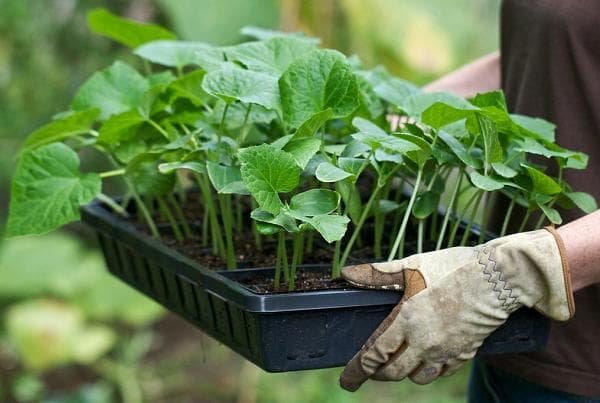
Conditions for growing eggplant seedlings at home
For successful cultivation of eggplants at home, you need to know 5 rules for choosing seeds:
- Productivity and resistance to temperature changes
- Choice between variety or hybrid
- Select the seeds corresponding to the region of growth
- Use prepared seeds
- Choose a trusted manufacturer
After the seed is purchased, it is necessary to carry out pre-sowing treatment:
- Seeds can be soaked in a weak solution of potassium permanganate
- Dissolve 3 ml of hydrogen peroxide in 100.0 water, heat to 40 degrees and lower the seeds for 10 minutes.
The land for sowing eggplant should be nutritious, light and friable with neutral acidity. We fill the container on ¾ with earth, plant a seed, cover it with soil, thoroughly moisten it with a weak solution of potassium permanganate and cover with film. Moisturize the soil can be melt water. Cold melt water promotes growth and gives strength to the future plant, making them more resistant to diseases.
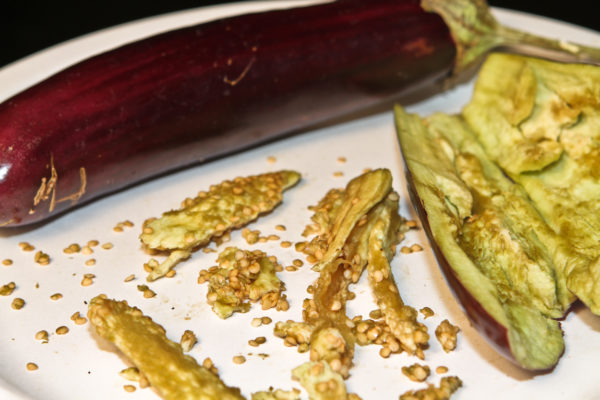
For good growth, you must follow the basic rules of care:
Lighting
For normal growth, eggplant seedlings, natural light may be lacking and it will have to be illuminated with a fitolamp or a fluorescent lamp. The distance between the lamp and the plant should be about half a meter, and the length of daylight hours from 7 to 19 hours.
Lack of lighting can lead to the pulling of seedlings, the seedlings weaken and lose their bright color. Such plants when planted in a permanent place are exposed to all sorts of diseases.
Watering
Watering must be done with warm settled water. Watering is done in the morning, using a spray bottle, so as not to wash the seeds or strip the roots. When watering it is necessary to ensure that water does not fall on the leaves and stems, as the spring sun can burn the young shoots.
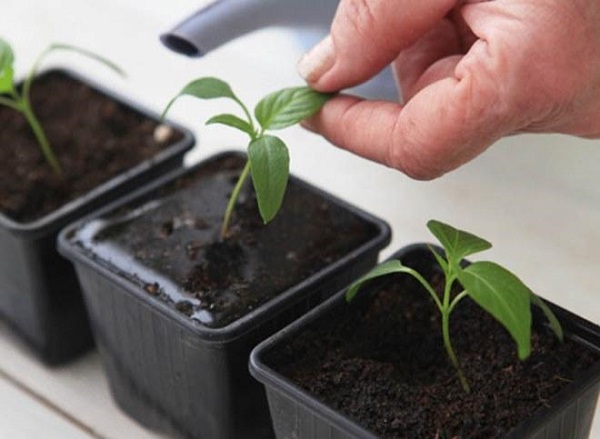
Top dressing
Eggplant seedlings, regardless of the quality of the soil needs additional feeding. With a good development of the plant, it is fertilized by light feeding. To do this, 250 ml of tea leaves, pour 3 liters of water and leave to infuse for a week.
If the seedlings grow in poorly nutritious soil or the plant does not grow well and loses its rich color, it is fertilized with complex fertilizers or self-prepared bait. To prepare, you need to take 1 teaspoonful of superphosphate and potassium sulfate, 2 teaspoons of complex fertilizer diluted in a bucket of water.
Wood ash or yeast solution can also be used as complementary foods. Ash is spread in a thin layer on the ground, trying not to fall on the leaves and stems. Preparation of yeast solution: 10 grams of dry yeast is diluted in 10 liters of water. Let it stand for 2-3 days. Before watering, the solution is diluted in a ratio of 1:10. All dressings must be combined with watering.
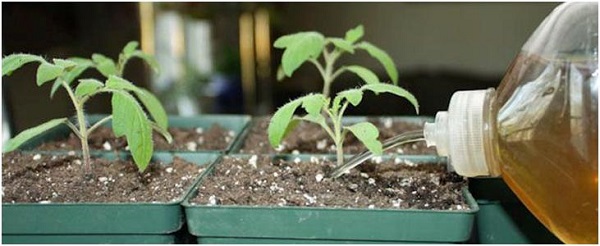
Extra care
After the formation of 2-3 true leaves, the plant is dived into larger pots. Capacity filled with nutrient mixture. The best place to go is the land where seeds used to sprout. The soil is shed with a solution prepared from wood ash, potassium sulfate or complex fertilizer.
At the rate of 1 hourspoon fertilizer on a bucket of water. Before diving, seedlings need to be shed. The seedling is carefully removed from the container, trying to take it with an earthy clod, and transfer it to a new container, deepening it to the cotyledon sheets. After transplantation, there should be no open area between the stem and the cotyledon leaves.
After a dive, the plant stops growing, increasing additional roots. After transplantation, seedlings do not water for 6 days and hide from the spring sun. After a week, watering is carried out every five days.
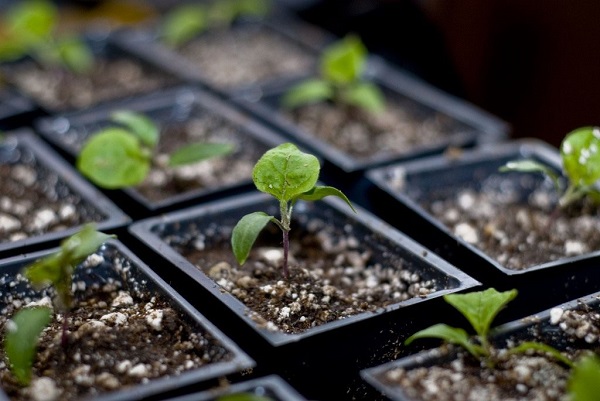
Temperature conditions
As soon as the sprouts hatch, the covering material is removed and the air temperature is lowered. 7 days after germination, it is necessary to adhere to the temperature regime, morning temperature should be 16-17 degrees, at night - 13-14 degrees. This temperature is necessary for good root development.
Then the temperature should be raised again: in the daytime - 25-27 degrees, at night - 13-14. The difference between day and night temperatures makes it possible to harden the seedlings so that they are resistant to changes in temperature when transplanting to a permanent place.
Although the cultivation of seedlings and not a simple matter, but with the observance of all the rules of caring for it, you can get a strong and healthy plant, which will delight with its fruits throughout the season.
